Patient education and counseling
VerifiedAdded on 2022/09/09
|8
|1906
|24
AI Summary
Contribute Materials
Your contribution can guide someone’s learning journey. Share your
documents today.

Running head: ANNOTATED BIBLIOGRAPHY
1
ANNOTATED BIBLIOGRAPHY
Name of the student
Name of the University
Author note
1
ANNOTATED BIBLIOGRAPHY
Name of the student
Name of the University
Author note
Secure Best Marks with AI Grader
Need help grading? Try our AI Grader for instant feedback on your assignments.

ANNOTATED BIBLIOGRAPHY 2
1.Aston, J., Wilson, K. A., & Terry, D. R. (2019). The treatment-related experiences of
parents, children and young people with regular prescribed medication. International
journal of clinical pharmacy, 41(1), 113-121.
Communication & technology-
Medication adherence is a burden on patient’s daily life. Several factors behind this
scenario have increased this problem in recent times. The experiences of taking these
medications have many adverse effects and leading to psychological distress among the patients.
The children and elderly people often face challenges of using it in schools, in front of neighbors.
It also hampers the regular activities and they have to rely on their family most of the cases.
In this case, some regimens are followed to reduce the increasing burden of the
medication adherence. A quality evaluation device can help both children and parents to assess
online data. In this context, ‘sign-post’ is advocated in quality provided internet-sites about
medication administration and dispensing. Health care providers give training on how to swallow
solid forms of medications to the children (Masilamoney & bDowse, 2018)
. Medication review has been implemented by pharmacists to minimize the medication waste.
Educational program has to be initiated to give advice and instructions to the patients during
travelling with medications. The proper integration among the patients, general practitioner and
pharmacists can benefit to optimize medication use. Timely shared information is one of the
guidelines for medicine optimization. Appropriate communication is needed among healthcare
providers, hospitals and patients to ensure treatment.
Tierney, S., Kirk, S., & Deaton, C. (2015). Transferring young people with cystic fibrosis to
adult care. Nursing Standard (2014+), 30(16), 41.
1.Aston, J., Wilson, K. A., & Terry, D. R. (2019). The treatment-related experiences of
parents, children and young people with regular prescribed medication. International
journal of clinical pharmacy, 41(1), 113-121.
Communication & technology-
Medication adherence is a burden on patient’s daily life. Several factors behind this
scenario have increased this problem in recent times. The experiences of taking these
medications have many adverse effects and leading to psychological distress among the patients.
The children and elderly people often face challenges of using it in schools, in front of neighbors.
It also hampers the regular activities and they have to rely on their family most of the cases.
In this case, some regimens are followed to reduce the increasing burden of the
medication adherence. A quality evaluation device can help both children and parents to assess
online data. In this context, ‘sign-post’ is advocated in quality provided internet-sites about
medication administration and dispensing. Health care providers give training on how to swallow
solid forms of medications to the children (Masilamoney & bDowse, 2018)
. Medication review has been implemented by pharmacists to minimize the medication waste.
Educational program has to be initiated to give advice and instructions to the patients during
travelling with medications. The proper integration among the patients, general practitioner and
pharmacists can benefit to optimize medication use. Timely shared information is one of the
guidelines for medicine optimization. Appropriate communication is needed among healthcare
providers, hospitals and patients to ensure treatment.
Tierney, S., Kirk, S., & Deaton, C. (2015). Transferring young people with cystic fibrosis to
adult care. Nursing Standard (2014+), 30(16), 41.
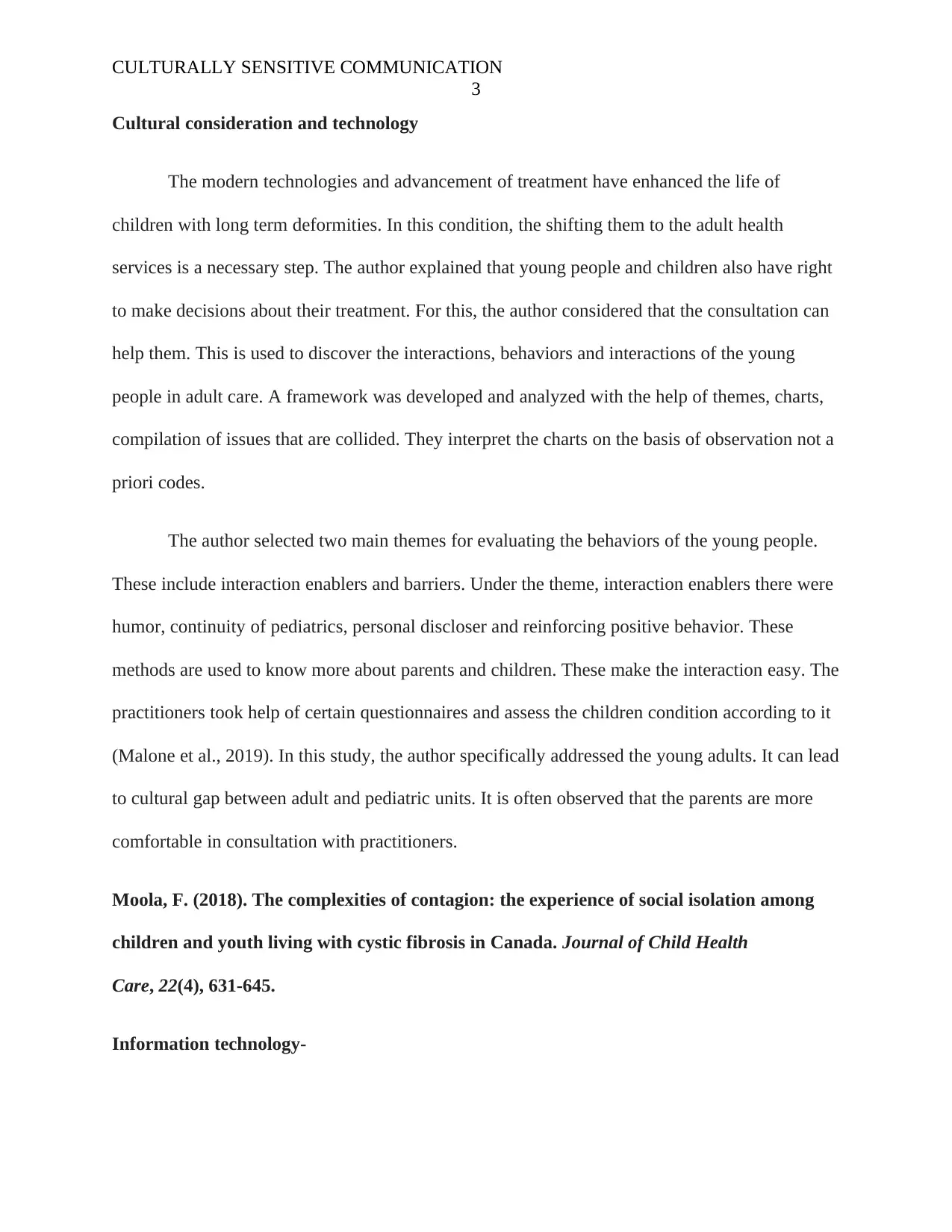
CULTURALLY SENSITIVE COMMUNICATION
3
Cultural consideration and technology
The modern technologies and advancement of treatment have enhanced the life of
children with long term deformities. In this condition, the shifting them to the adult health
services is a necessary step. The author explained that young people and children also have right
to make decisions about their treatment. For this, the author considered that the consultation can
help them. This is used to discover the interactions, behaviors and interactions of the young
people in adult care. A framework was developed and analyzed with the help of themes, charts,
compilation of issues that are collided. They interpret the charts on the basis of observation not a
priori codes.
The author selected two main themes for evaluating the behaviors of the young people.
These include interaction enablers and barriers. Under the theme, interaction enablers there were
humor, continuity of pediatrics, personal discloser and reinforcing positive behavior. These
methods are used to know more about parents and children. These make the interaction easy. The
practitioners took help of certain questionnaires and assess the children condition according to it
(Malone et al., 2019). In this study, the author specifically addressed the young adults. It can lead
to cultural gap between adult and pediatric units. It is often observed that the parents are more
comfortable in consultation with practitioners.
Moola, F. (2018). The complexities of contagion: the experience of social isolation among
children and youth living with cystic fibrosis in Canada. Journal of Child Health
Care, 22(4), 631-645.
Information technology-
3
Cultural consideration and technology
The modern technologies and advancement of treatment have enhanced the life of
children with long term deformities. In this condition, the shifting them to the adult health
services is a necessary step. The author explained that young people and children also have right
to make decisions about their treatment. For this, the author considered that the consultation can
help them. This is used to discover the interactions, behaviors and interactions of the young
people in adult care. A framework was developed and analyzed with the help of themes, charts,
compilation of issues that are collided. They interpret the charts on the basis of observation not a
priori codes.
The author selected two main themes for evaluating the behaviors of the young people.
These include interaction enablers and barriers. Under the theme, interaction enablers there were
humor, continuity of pediatrics, personal discloser and reinforcing positive behavior. These
methods are used to know more about parents and children. These make the interaction easy. The
practitioners took help of certain questionnaires and assess the children condition according to it
(Malone et al., 2019). In this study, the author specifically addressed the young adults. It can lead
to cultural gap between adult and pediatric units. It is often observed that the parents are more
comfortable in consultation with practitioners.
Moola, F. (2018). The complexities of contagion: the experience of social isolation among
children and youth living with cystic fibrosis in Canada. Journal of Child Health
Care, 22(4), 631-645.
Information technology-
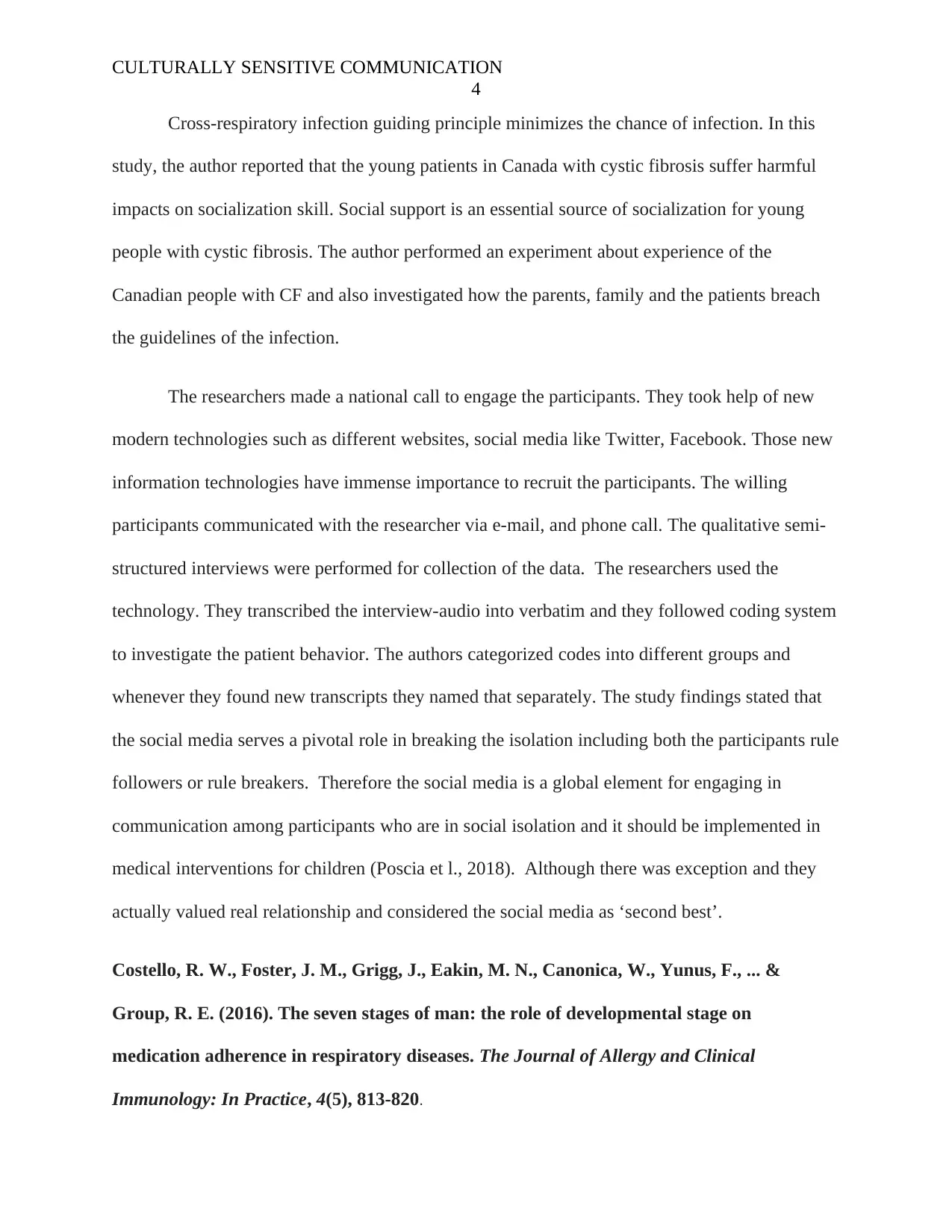
CULTURALLY SENSITIVE COMMUNICATION
4
Cross-respiratory infection guiding principle minimizes the chance of infection. In this
study, the author reported that the young patients in Canada with cystic fibrosis suffer harmful
impacts on socialization skill. Social support is an essential source of socialization for young
people with cystic fibrosis. The author performed an experiment about experience of the
Canadian people with CF and also investigated how the parents, family and the patients breach
the guidelines of the infection.
The researchers made a national call to engage the participants. They took help of new
modern technologies such as different websites, social media like Twitter, Facebook. Those new
information technologies have immense importance to recruit the participants. The willing
participants communicated with the researcher via e-mail, and phone call. The qualitative semi-
structured interviews were performed for collection of the data. The researchers used the
technology. They transcribed the interview-audio into verbatim and they followed coding system
to investigate the patient behavior. The authors categorized codes into different groups and
whenever they found new transcripts they named that separately. The study findings stated that
the social media serves a pivotal role in breaking the isolation including both the participants rule
followers or rule breakers. Therefore the social media is a global element for engaging in
communication among participants who are in social isolation and it should be implemented in
medical interventions for children (Poscia et l., 2018). Although there was exception and they
actually valued real relationship and considered the social media as ‘second best’.
Costello, R. W., Foster, J. M., Grigg, J., Eakin, M. N., Canonica, W., Yunus, F., ... &
Group, R. E. (2016). The seven stages of man: the role of developmental stage on
medication adherence in respiratory diseases. The Journal of Allergy and Clinical
Immunology: In Practice, 4(5), 813-820.
4
Cross-respiratory infection guiding principle minimizes the chance of infection. In this
study, the author reported that the young patients in Canada with cystic fibrosis suffer harmful
impacts on socialization skill. Social support is an essential source of socialization for young
people with cystic fibrosis. The author performed an experiment about experience of the
Canadian people with CF and also investigated how the parents, family and the patients breach
the guidelines of the infection.
The researchers made a national call to engage the participants. They took help of new
modern technologies such as different websites, social media like Twitter, Facebook. Those new
information technologies have immense importance to recruit the participants. The willing
participants communicated with the researcher via e-mail, and phone call. The qualitative semi-
structured interviews were performed for collection of the data. The researchers used the
technology. They transcribed the interview-audio into verbatim and they followed coding system
to investigate the patient behavior. The authors categorized codes into different groups and
whenever they found new transcripts they named that separately. The study findings stated that
the social media serves a pivotal role in breaking the isolation including both the participants rule
followers or rule breakers. Therefore the social media is a global element for engaging in
communication among participants who are in social isolation and it should be implemented in
medical interventions for children (Poscia et l., 2018). Although there was exception and they
actually valued real relationship and considered the social media as ‘second best’.
Costello, R. W., Foster, J. M., Grigg, J., Eakin, M. N., Canonica, W., Yunus, F., ... &
Group, R. E. (2016). The seven stages of man: the role of developmental stage on
medication adherence in respiratory diseases. The Journal of Allergy and Clinical
Immunology: In Practice, 4(5), 813-820.
Secure Best Marks with AI Grader
Need help grading? Try our AI Grader for instant feedback on your assignments.
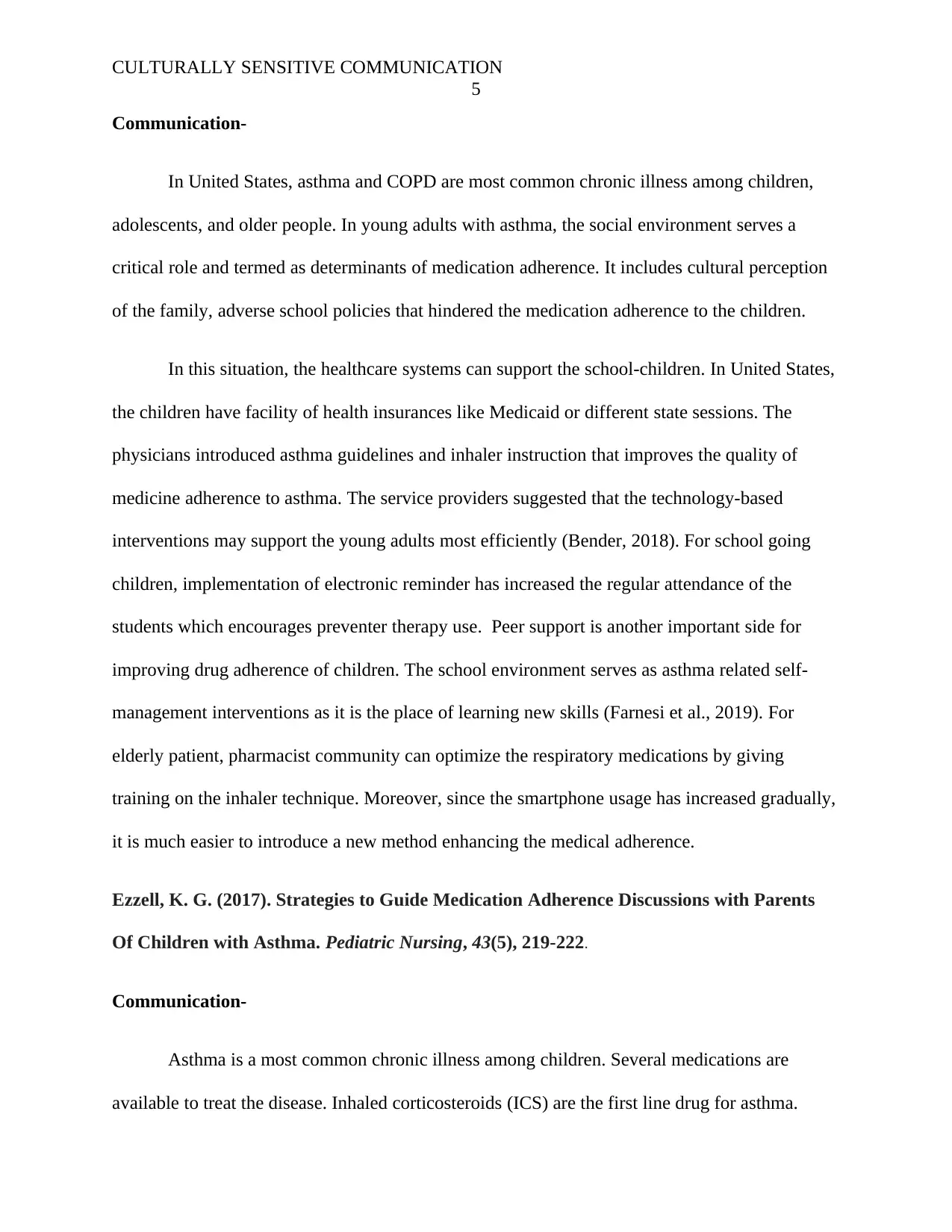
CULTURALLY SENSITIVE COMMUNICATION
5
Communication-
In United States, asthma and COPD are most common chronic illness among children,
adolescents, and older people. In young adults with asthma, the social environment serves a
critical role and termed as determinants of medication adherence. It includes cultural perception
of the family, adverse school policies that hindered the medication adherence to the children.
In this situation, the healthcare systems can support the school-children. In United States,
the children have facility of health insurances like Medicaid or different state sessions. The
physicians introduced asthma guidelines and inhaler instruction that improves the quality of
medicine adherence to asthma. The service providers suggested that the technology-based
interventions may support the young adults most efficiently (Bender, 2018). For school going
children, implementation of electronic reminder has increased the regular attendance of the
students which encourages preventer therapy use. Peer support is another important side for
improving drug adherence of children. The school environment serves as asthma related self-
management interventions as it is the place of learning new skills (Farnesi et al., 2019). For
elderly patient, pharmacist community can optimize the respiratory medications by giving
training on the inhaler technique. Moreover, since the smartphone usage has increased gradually,
it is much easier to introduce a new method enhancing the medical adherence.
Ezzell, K. G. (2017). Strategies to Guide Medication Adherence Discussions with Parents
Of Children with Asthma. Pediatric Nursing, 43(5), 219-222.
Communication-
Asthma is a most common chronic illness among children. Several medications are
available to treat the disease. Inhaled corticosteroids (ICS) are the first line drug for asthma.
5
Communication-
In United States, asthma and COPD are most common chronic illness among children,
adolescents, and older people. In young adults with asthma, the social environment serves a
critical role and termed as determinants of medication adherence. It includes cultural perception
of the family, adverse school policies that hindered the medication adherence to the children.
In this situation, the healthcare systems can support the school-children. In United States,
the children have facility of health insurances like Medicaid or different state sessions. The
physicians introduced asthma guidelines and inhaler instruction that improves the quality of
medicine adherence to asthma. The service providers suggested that the technology-based
interventions may support the young adults most efficiently (Bender, 2018). For school going
children, implementation of electronic reminder has increased the regular attendance of the
students which encourages preventer therapy use. Peer support is another important side for
improving drug adherence of children. The school environment serves as asthma related self-
management interventions as it is the place of learning new skills (Farnesi et al., 2019). For
elderly patient, pharmacist community can optimize the respiratory medications by giving
training on the inhaler technique. Moreover, since the smartphone usage has increased gradually,
it is much easier to introduce a new method enhancing the medical adherence.
Ezzell, K. G. (2017). Strategies to Guide Medication Adherence Discussions with Parents
Of Children with Asthma. Pediatric Nursing, 43(5), 219-222.
Communication-
Asthma is a most common chronic illness among children. Several medications are
available to treat the disease. Inhaled corticosteroids (ICS) are the first line drug for asthma.
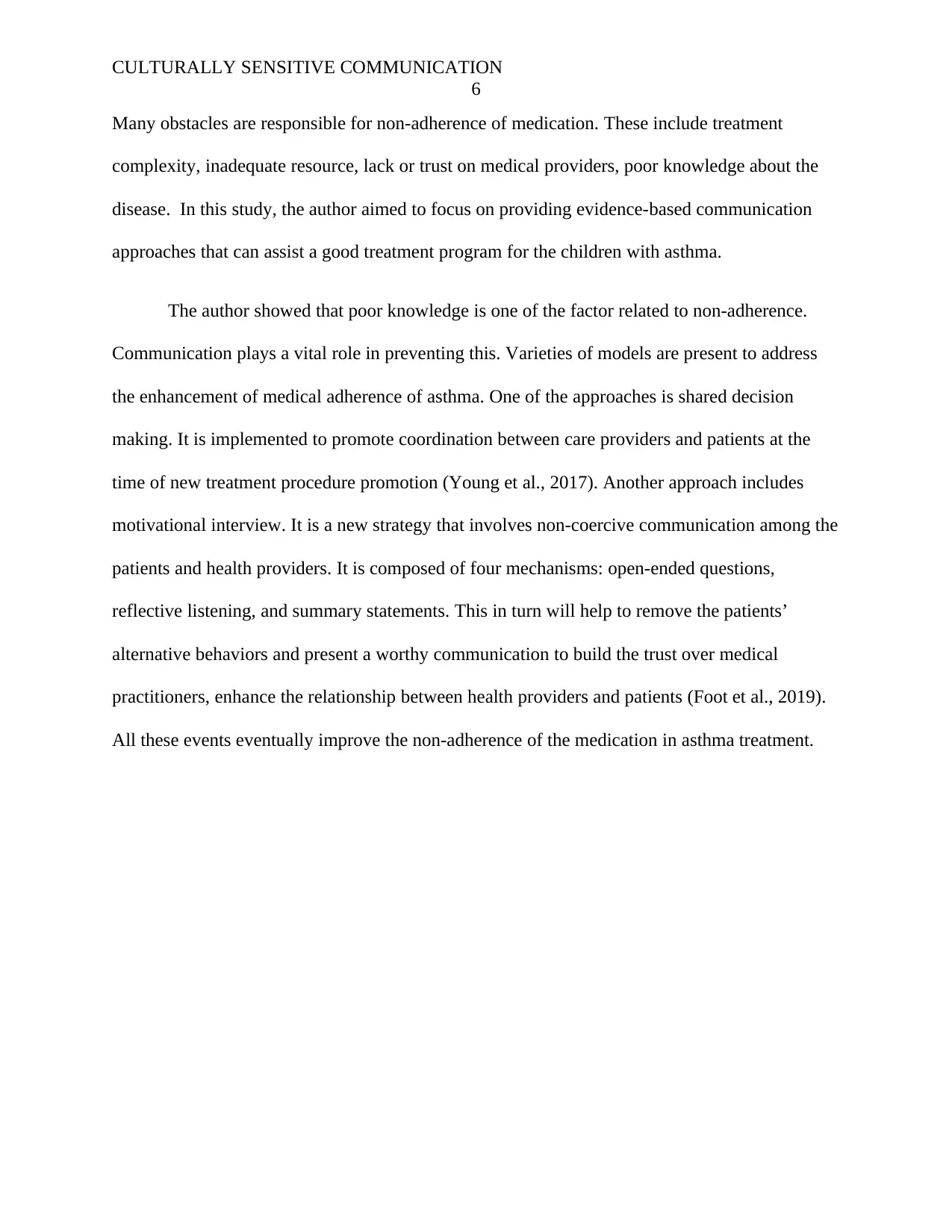
CULTURALLY SENSITIVE COMMUNICATION
6
Many obstacles are responsible for non-adherence of medication. These include treatment
complexity, inadequate resource, lack or trust on medical providers, poor knowledge about the
disease. In this study, the author aimed to focus on providing evidence-based communication
approaches that can assist a good treatment program for the children with asthma.
The author showed that poor knowledge is one of the factor related to non-adherence.
Communication plays a vital role in preventing this. Varieties of models are present to address
the enhancement of medical adherence of asthma. One of the approaches is shared decision
making. It is implemented to promote coordination between care providers and patients at the
time of new treatment procedure promotion (Young et al., 2017). Another approach includes
motivational interview. It is a new strategy that involves non-coercive communication among the
patients and health providers. It is composed of four mechanisms: open-ended questions,
reflective listening, and summary statements. This in turn will help to remove the patients’
alternative behaviors and present a worthy communication to build the trust over medical
practitioners, enhance the relationship between health providers and patients (Foot et al., 2019).
All these events eventually improve the non-adherence of the medication in asthma treatment.
6
Many obstacles are responsible for non-adherence of medication. These include treatment
complexity, inadequate resource, lack or trust on medical providers, poor knowledge about the
disease. In this study, the author aimed to focus on providing evidence-based communication
approaches that can assist a good treatment program for the children with asthma.
The author showed that poor knowledge is one of the factor related to non-adherence.
Communication plays a vital role in preventing this. Varieties of models are present to address
the enhancement of medical adherence of asthma. One of the approaches is shared decision
making. It is implemented to promote coordination between care providers and patients at the
time of new treatment procedure promotion (Young et al., 2017). Another approach includes
motivational interview. It is a new strategy that involves non-coercive communication among the
patients and health providers. It is composed of four mechanisms: open-ended questions,
reflective listening, and summary statements. This in turn will help to remove the patients’
alternative behaviors and present a worthy communication to build the trust over medical
practitioners, enhance the relationship between health providers and patients (Foot et al., 2019).
All these events eventually improve the non-adherence of the medication in asthma treatment.

CULTURALLY SENSITIVE COMMUNICATION
7
Reference
Bender, B. G. (2018). Technology interventions for nonadherence: new approaches to an old
problem. The Journal of Allergy and Clinical Immunology: In Practice, 6(3), 794-800.
Custer, A. M., Walter, M., & Scheier, L. M. (2016). Web-Based Interventions for Treating
Youth with Asthma: Is Efficacy on the Horizon.
Farnesi, B. C., Ducharme, F. M., Blais, L., Collin, J., Lavoie, K. L., Bacon, S. L., McKinney, M.
L., & Peláez, S. (2019). Guided asthma self-management or patient self-adjustment?
Using patients' narratives to better understand adherence to asthma treatment. Patient
preference and adherence, 13, 587–597. https://doi.org/10.2147/PPA.S195585
Foot, H., La Caze, A., Baker, P., & Cottrell, N. (2019). Better understanding the influence and
complexity of beliefs on medication adherence in asthma. Patient education and
counseling, 102(3), 564-570.
Malone, H., Biggar, S., Javadpour, S., Edworthy, Z., Sheaf, G., & Coyne, I. (2019). Interventions
for promoting participation in shared decision‐making for children and adolescents with
cystic fibrosis. Cochrane Database of Systematic Reviews, (5).
Masilamoney, M., & Dowse, R. (2018). Knowledge and practice of healthcare professionals
relating to oral medicine use in swallowing‐impaired patients: a scoping
review. International Journal of Pharmacy Practice, 26(3), 199-209.
Poscia, A., Stojanovic, J., La Milia, D. I., Duplaga, M., Grysztar, M., Moscato, U., ... &
Magnavita, N. (2018). Interventions targeting loneliness and social isolation among the
older people: An update systematic review. Experimental gerontology, 102, 133-144.
7
Reference
Bender, B. G. (2018). Technology interventions for nonadherence: new approaches to an old
problem. The Journal of Allergy and Clinical Immunology: In Practice, 6(3), 794-800.
Custer, A. M., Walter, M., & Scheier, L. M. (2016). Web-Based Interventions for Treating
Youth with Asthma: Is Efficacy on the Horizon.
Farnesi, B. C., Ducharme, F. M., Blais, L., Collin, J., Lavoie, K. L., Bacon, S. L., McKinney, M.
L., & Peláez, S. (2019). Guided asthma self-management or patient self-adjustment?
Using patients' narratives to better understand adherence to asthma treatment. Patient
preference and adherence, 13, 587–597. https://doi.org/10.2147/PPA.S195585
Foot, H., La Caze, A., Baker, P., & Cottrell, N. (2019). Better understanding the influence and
complexity of beliefs on medication adherence in asthma. Patient education and
counseling, 102(3), 564-570.
Malone, H., Biggar, S., Javadpour, S., Edworthy, Z., Sheaf, G., & Coyne, I. (2019). Interventions
for promoting participation in shared decision‐making for children and adolescents with
cystic fibrosis. Cochrane Database of Systematic Reviews, (5).
Masilamoney, M., & Dowse, R. (2018). Knowledge and practice of healthcare professionals
relating to oral medicine use in swallowing‐impaired patients: a scoping
review. International Journal of Pharmacy Practice, 26(3), 199-209.
Poscia, A., Stojanovic, J., La Milia, D. I., Duplaga, M., Grysztar, M., Moscato, U., ... &
Magnavita, N. (2018). Interventions targeting loneliness and social isolation among the
older people: An update systematic review. Experimental gerontology, 102, 133-144.
Paraphrase This Document
Need a fresh take? Get an instant paraphrase of this document with our AI Paraphraser
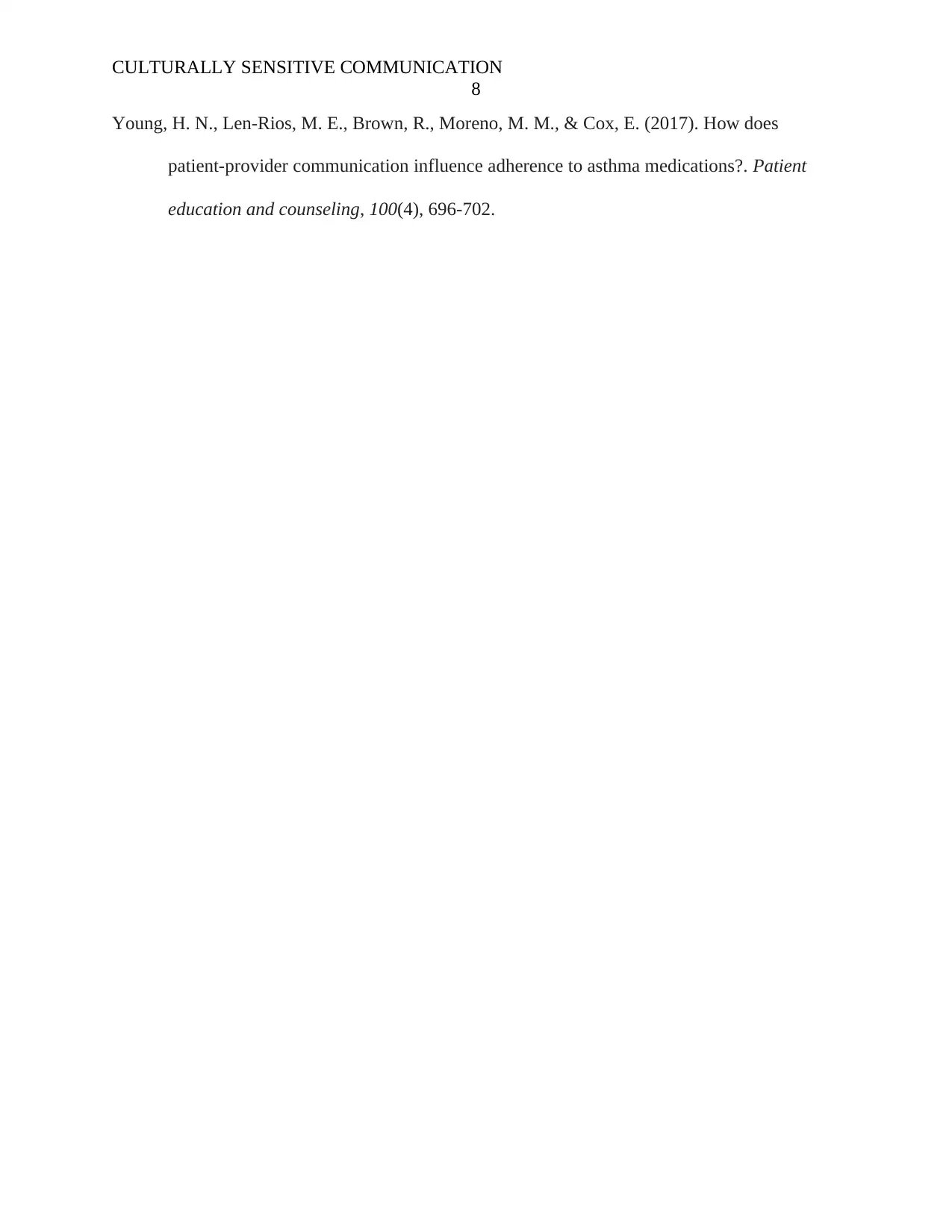
CULTURALLY SENSITIVE COMMUNICATION
8
Young, H. N., Len-Rios, M. E., Brown, R., Moreno, M. M., & Cox, E. (2017). How does
patient-provider communication influence adherence to asthma medications?. Patient
education and counseling, 100(4), 696-702.
8
Young, H. N., Len-Rios, M. E., Brown, R., Moreno, M. M., & Cox, E. (2017). How does
patient-provider communication influence adherence to asthma medications?. Patient
education and counseling, 100(4), 696-702.
1 out of 8
Your All-in-One AI-Powered Toolkit for Academic Success.
+13062052269
info@desklib.com
Available 24*7 on WhatsApp / Email
![[object Object]](/_next/static/media/star-bottom.7253800d.svg)
Unlock your academic potential
© 2024 | Zucol Services PVT LTD | All rights reserved.

